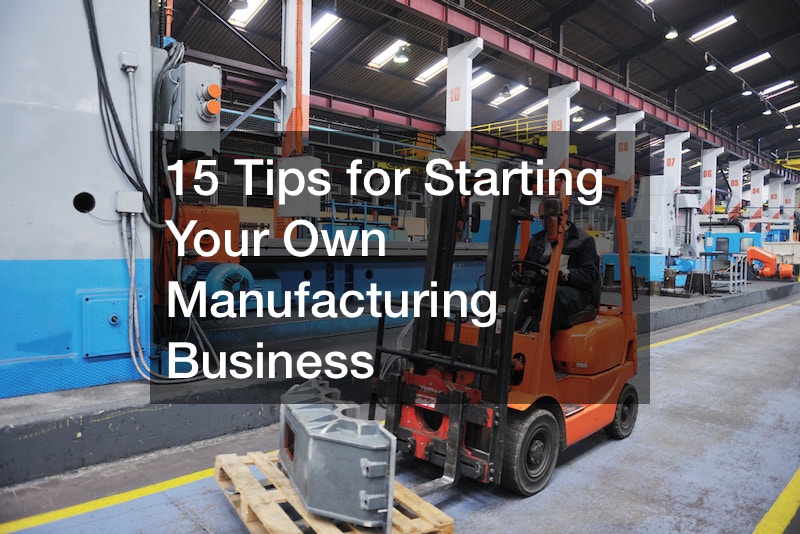Although it’s not a walk in the park, starting a manufacturing business is brilliant and highly rewarding. If it weren’t, there wouldn’t be so many industries that rely heavily on this sector. These include food and beverages, textiles, wood and paper, metal and machinery, electronics, furniture, transportation, and more. Manufacturing involves transforming materials or components into new finished products which can be sold in the marketplace.
The final products can be finished goods for sale to customers or intermediate goods used in production. Since the industrial revolution, manufacturing has become increasingly important, with many products being mass-produced. Mass production means producing goods more quickly and precisely, reducing prices. Here are some useful pointers to help you get started.
1. Start Small
Manufacturing can sound like cooperation with big plants and heavy machinery. However, you can start a small-scale business with products designed for small-scale manufacturing. Starting small saves you the risk of a big financial investment but also gives you a chance to be ready to scale when an opportunity presents itself. Also, with less capital, there’s less pressure to hit that home run with your first product idea. You can test it out in the market to see if people like it, and you can make alterations to understand your business idea and its possibilities as you progressively learn how to grow your manufacturing business.
2. Decide What You Want to Make
Before a raw material becomes a final product, it undergoes some engineering, known as the manufacturing process, which starts with a product design, followed by the specification of the material from which the product is manufactured. It’s the manufacturing process that modifies these materials into products.
Begin by predetermining the design you’ll make and sell, why you’re making it, and who your potential market is. Do your homework to establish a preexisting or potential market for your product. This is a great way to learn how to grow a manufacturing business.
After conceptualizing the design, use the free design software to establish your proof of concept before making cuts or molds.

3. Choose a Fast-Moving or Versatile Product
A product with multiple market opportunities or outlets is the most viable. A great way to get your feet wet and learn how to grow manufacturing business is venturing into the food industry. For instance, urban mini-farms are catching on. The idea is to cultivate herbs vertically, usually in shipping containers.
Cultivation is done using the economical and environmentally friendly hydroponics method. According to a report by Allthatgrows, one container allows you to grow more than 20 kilograms of herbs per week all year round. It’s also possible to grow healthy microgreens too. Because it’s mobile, the farm can be installed anywhere, even in the city, making it possible to quickly supply restaurants, supermarkets, schools, and homes with fresh herbs. Soy lecithin manufacturing is another versatile venture. It’s used in food, feeds, technical industries, and pharmaceuticals.
Another handy idea is bulk disinfecting wipes. With the world adapting to hygiene consciousness, especially after the ravaging COVID-19 pandemic, you can supply these wipes to hospitals, schools, gyms, community centers, and other public facilities.
4. Advertising and Marketing
A product needs visibility. Marketing is one of the key aspects of a start-up business layout. Start by writing a marketing strategy for your goods. Knowing your competition and their percentage market penetration is crucial for planning sales strategies and merchandising methods. Also, understand if your market is a growth or static one if it has seasonal characteristics, and what market percentage you’ll be shooting for.
Advertising and marketing can affect the success of your business. Although it’s not cheap, it’s critical for the success of your manufacturing business. Start by setting an advertising budget. The good thing is that some advertising channels are free. For instance, networking with other professionals, social media marketing, and video marketing channels are free. While free is relative, since you’ll spend a lot of time making videos and posting them, it’s one of the best ways to learn how to grow manufacturing business.
Market analysis and feedback should direct your production goals and plans. Make the unique characteristics of your product the basis of your advertising and sales promotion strategies. Performance, durability, ease of operation, versatility, speed or accuracy, ease of maintenance or repair, size or weight, and more should inform your advertising and marketing strategy.

5. Decide How You Want to Structure Your Company
Your goals will define whether you’re a sole proprietorship, incorporation partnership, or limited liability cooperation. You’ll need to develop a management team to help you keep up with market research, make crucial decisions and get counsel on how to grow manufacturing business. Partnering provides an opportunity to scale big, and depending on your planned production capacity and investment capabilities, you can have a plant, a mill, or a factory.
6. Choose Your Production Equipment
The type of machinery you invest in will be determined by the transformational process your product needs to pass through, either physical, chemical, or mechanical. Some productions require only one machine. Others require multiple types of machinery; for instance, for custom sheet metal fabrications, you’ll need several machines (for cutting, turret punching, forming the sheet, bending and rolling it, or sometimes welding).
If your production requires a high pressure compressor manufacturing apparatus to have a long service life and withstand strenuous operating conditions, it’ll need protection from oil slugs, compressor air, or oil separator failure. Using a mist eliminator manufacturer gear simultaneously is necessary as it improves product quality, reduces energy costs, and protects production equipment. The way to curb losses is by learning how to grow manufacturing business.
You can contract manufacturers to do what you don’t have the means for. Still, you can take your designs to a local makerspace or look up machining services on the internet. Even without the burden of machinery maintenance, you still have to figure out what machines do what and at what stage of your product, and one way of doing this is outsourcing this part of your business.
If your products only need micro machining, manufacture them in-house by setting up a shop. Use available machinery on rent or purchase; the goal is to get started and scale up as your business grows.
7. Determine Your Distribution
Getting your product to the ultimate consumer is a vital process of your business. You can sell directly through your own sales organization or indirectly through a manufacturer’s agents, brokers, or wholesalers. Start by listing your potential customers by name, the total amount they’ll spend on your products, and the amount they’ll spend on each. If you plan to sell your product overseas, enter into a parcel shipping contract with a reliable shipper. This part of logistics is critical for the success of your business.

8. Manufacturing Operation
List the basic processes your product will go through. You wouldn’t want a scenario where your business halts production because you run out of raw materials. Make an inventory of all the raw materials and supplies you’ll need and where you’ll source them. You also need to know the amount of raw material or components you’ll need to stock and if there’re special considerations about storage requirements. For instance, some raw materials like chemicals lose their potency after a short storage period. Be up to speed with what you need before starting the manufacturing process. Consistency in production is the holy grail of how to grow manufacturing business.
9. Get Labor Skills
You’ll require expert labor skills to run your production equipment. Factor in indirect labor as well. For example, material handlers, stockmen, cleaning staff, and others are needed to keep the machines running. If these workers aren’t on your payroll, at least know where you’ll source them from. An employment agency is a good place to make inquiries from.
If you intend to do the job yourself, find out what skills you’ll need to learn. Also, explore outsourcing options just in case you can’t handle the task on your own.
10. Space
If you start small, perhaps in your garage like the late Steve Jobs, your goal should be to learn how to grow manufacturing business. As you grow, consider the space you’ll need to manufacture your products and storage rooms for raw materials and products. Include restrooms and employee parking facilities where necessary, and find out if there’re local ordinances you need to comply with. If you’re a patio paver manufacturer of natural stone options like granite and limestone, you’ll need proper storage as these products can be delicate, bulky, or both. The best storage, in this case, is one that minimizes risk while handling.
11. Overheads
You’ll need a contingency budget for overheads. These are extra expenses on tools, supplies, utilities, office help, telephone, payroll taxes, holidays, vacations, and salaries for your key people. If you’re starting by yourself, this part of your budget may not be critical, but it’ll be as your business grows.
12. Get Funds
Money is a tool for growing your business, and learning how to grow manufacturing business is a great way to use it. However, you need initial capital now that you know what you want to manufacture. It’s crunch time after drawing up your budget and clearly outlining how much you’ll need for your project! This is the time to bite the bullet and soldier on with the project or step back until funds are available. If your calculations show that you’ll spend more than you’ll make for several months before breaking even or making a profit (as most successful businesses do), establish where you’ll get financial reserves to carry you during this period.
You can take a loan, in which case you’re responsible for paying it back. However, you must show the lender that you can repay the loan. You’ll also need to demonstrate to them how you intend to repay it and by when.

13. Projected Sales and Expenses
You don’t want to start something you can’t sustain. To determine if your product will make its way to the marketplace, estimate your sales and expense figures for at least 12 months. However, projections are worthless if they’re unachievable. They, however, keep you focused on what must be done now to get where you want to be tomorrow.
14. Estimate Cash Flow
Cash must flow into the business properly if bills are to be paid and profits realized at the end of the year. To determine whether your projected sales and expense figures are realistic, prepare a cash flow forecast for the 12 months covered by your estimates of sales and expenses.
15. Get the Work Done
Your business is only partway home at the planning stage. Beyond this stage, you’ll need to get organized, which involves getting other players on board. You’ll quickly find out you can’t do everything. You’ll need to delegate responsibilities and authority to others. A helpful tool in getting this done is the organization chart, which shows who’s responsible for the major activities of a business. However, no matter how your operation is organized, you don’t know how to grow manufacturing business until you’ve perfected financial management.
In the beginning, you’re probably the president of your startup company, and you will most likely do everything. However, your business won’t grow beyond you if you don’t bring others on board. You can outsource services or functions as needed, gradually scaling up until yours becomes one of the successful business stories.
There are many regaling tales of how some of today’s conglomerates started from such humble beginnings as a garage. Although some sound too good to be true, others, like Apple Inc and Amazon, are testimonies of what sheer grit and determination can yield. These were started by men armed with an idea and dogged determination to succeed.
If you want to make it big, the manufacturing industry is the way to go. While you can start a manufacturing business yourself, you soon realize you need to outsource some tasks. Nonetheless, as your business grows, organization becomes a critical element. Everyone and everything must be coordinated and guided toward optimal performance and output. Despite the initial challenges, if you work diligently and stay with the process, yours will be one of those manufacturing businesses that grow from humble beginnings to become behemoths in their niche. Don’t give up!


